Elizabeth Andrews's Blog, page 14
February 1, 2015
1st February Imbolc and the feast of St Brigid
This day is the festival of Imbolc( or Oimlec) which marked the
beginning of spring in the Celtic calender. It merged with the feast day of St Brigid, the Abbess of Kildare in the late fifth and early sixth century. She was one of Ireland's best loved saints as well as being revered in England and Scotland.
Her feast day is celebrated in Ireland with various traditions, which included the making of rush crosses and the eating of festive fare. And as she is the patron saint of dairymaids and her emblem the cow, many of the festive recipes included milk and butter which would be consumed on Imbolc Eve, food such as colcannon, sowans, dumplings, barmbrack and bannocks. On this night Brigid was said to visit virtuous households and bless the residents so in thanks some of the food would be set aside for her.
Before the residents retire to bed they would leave items of clothing or strips of cloth ouside for the saint to bless, the ashes in the fireplace would be raked smooth so that in the morning they could look for some kind of mark in the ash that Brigid had visited the house.
The clothing and cloth would be brought back inside and treasured as they believed that it would now have powers of healing and protection.
St Brigid was also suppose to have helped the Virgin Mary give birth to Jesus, so becoming the protector to pregnant women and midwives. She also tended to Mary's cows earning herself the title of 'Christ's Milkmaid.'
In the Highlands on the feast day young girls make the 'Last Sheaf'' of the previous harvest
into images of her which are then laid in a decorated cradle called the 'Brides Bed'.
'This is the day of the BrideThe Queen will come from the moundThis is the day of the BrideThe serpent will come from the hole'
It is believed that on this holy day that adders would issue forth from their winters lairs bringing spring with them.
'The serpent will come from the holeOn the brown day of Bride,Though there should be three feet of snowOn the flat surface of the ground'
This day celebrates the reawakening of the earth and is the time of new beginnings. It is also an opportunity for us to make use of our intuitive energy and inner wisdom which, hopefully, we have gained during the winter months.
It is also the day when Cailleach, the hag of Gaelic tradition, gathers her firewood for the rest of the winter. It is said that if the winetr is going to last a good while longer, she will make sure that the weather on Imbolc is bright and sunny enabling her to gather plenty of firewood.
( the weather today is bright and sunny, oh dear!)
This beliefs is supposed to be the forerunner of Groundhog Day in America
Published on February 01, 2015 04:32
January 16, 2015
Faerie rings:- Ring of fungus which grows in grass or tur...
Faerie rings:- Ring of fungus which grows in grass or turf.
This is where faeries and witches gather to dance and sing so it can be a very dangerous place to step in unaware.
If you are drawn inside you can only escape the dancing faeries if a human chain pulls you out of the ring. You will lose all sense of time and what might have seemed like minutes could have been hours.
But this is the down side of faerie rings, there are some advantages.
If you run around a faerie ring nine times under a full moon this will enable you to see and hear the faeries, but do not do it on All Hallows Eve or May Eve as these are very important faerie festivals. They would be very offended and carry you off to faerie land.
If you would like a wish granted you have to stand in the middle of the ring under a full moon and it will come true. How you are supposed to do this without getting caught up in the dancing I don’t know, but give it a go, just remember to take back-up.

There are many mushrooms that form Faerie Rings, some are edible but there are quite a few that are extremely dangerous to eat.Mostly found in grass but can also be seen in woodland.Faerie courts, Faerie dances, Faerie walks, and Hag tracks are just a few of the names these rings have been known as over the years.Some of the Faerie Rings can grow for manyyears and reach enormous sizes, the largest was supposed to have been 650 metres across and it was believed to be over 700 years old.

St Georges Mushroom.This one forms one of the largest Faerie Rings, found in fields onchalky soil.
Fairy Ring Champignon.One of the most common, forms large rings especially on lawns.Appears in earlysummer after rain.In Victorian times it was knownas Scotch Bonnet.
Cream Clot.Appears later in the Summerbut often grows in the same Ring as the above.
Meadow Puffball.This is found in grassland including lawns.
Buff Meadow Cap.Found in grasslands sometimes in open woodlands.
Young girls would often bathe their face in early morning dew to improve their looks,
but the dew from inside a Faerie Ring would have the opposite effect.
Their skin would erupt in warts and spots.
This is where faeries and witches gather to dance and sing so it can be a very dangerous place to step in unaware.
If you are drawn inside you can only escape the dancing faeries if a human chain pulls you out of the ring. You will lose all sense of time and what might have seemed like minutes could have been hours.
But this is the down side of faerie rings, there are some advantages.
If you run around a faerie ring nine times under a full moon this will enable you to see and hear the faeries, but do not do it on All Hallows Eve or May Eve as these are very important faerie festivals. They would be very offended and carry you off to faerie land.
If you would like a wish granted you have to stand in the middle of the ring under a full moon and it will come true. How you are supposed to do this without getting caught up in the dancing I don’t know, but give it a go, just remember to take back-up.

There are many mushrooms that form Faerie Rings, some are edible but there are quite a few that are extremely dangerous to eat.Mostly found in grass but can also be seen in woodland.Faerie courts, Faerie dances, Faerie walks, and Hag tracks are just a few of the names these rings have been known as over the years.Some of the Faerie Rings can grow for manyyears and reach enormous sizes, the largest was supposed to have been 650 metres across and it was believed to be over 700 years old.

St Georges Mushroom.This one forms one of the largest Faerie Rings, found in fields onchalky soil.
Fairy Ring Champignon.One of the most common, forms large rings especially on lawns.Appears in earlysummer after rain.In Victorian times it was knownas Scotch Bonnet.
Cream Clot.Appears later in the Summerbut often grows in the same Ring as the above.
Meadow Puffball.This is found in grassland including lawns.
Buff Meadow Cap.Found in grasslands sometimes in open woodlands.
Young girls would often bathe their face in early morning dew to improve their looks,
but the dew from inside a Faerie Ring would have the opposite effect.
Their skin would erupt in warts and spots.
Published on January 16, 2015 02:54
January 12, 2015
How to protect against faeries.....
[image error]
 There are times when you will need to protect yourself against faeries as not all the fae are pleasant!If you are walking at night in places inhabited by faeries carry a cross, especially one made of iron. Making the sign of the cross is also effective; carry holy water, chant hymns and say prayers as you walk. Carrying or throwing churchyard mould in their path will deter them. Alternatively carry bread or salt; something that is readily available to all of us; they are both regarded as sacred symbols.
There are times when you will need to protect yourself against faeries as not all the fae are pleasant!If you are walking at night in places inhabited by faeries carry a cross, especially one made of iron. Making the sign of the cross is also effective; carry holy water, chant hymns and say prayers as you walk. Carrying or throwing churchyard mould in their path will deter them. Alternatively carry bread or salt; something that is readily available to all of us; they are both regarded as sacred symbols.
‘For that holy piece of breadCharms the danger and the dread’
Green moss taken from a mill stream, pouring salt onto the table and saying the Lords Prayer three times is also an effective protection.The ringing of bells will drive away faeries and witches. They cannot abide the sound of church bells, it was with the hanging of the first bells in the church on Portland, Dorset that caused the large population of faeries to leave the isle. At the first peal they were seen fleeing along Chesil Beach.They were also driven away from Cadbury Castle in Somerset, an old hill fort, by the sound of the newly erected church bells nearby. They left so quickly that they did not stop to retrieve their horde of faerie gold hidden deep in the hillside.
If you come across faeries on All Hallows Eve, Halloween,, make sure you throw some of the dirt from your own footprint after the faeries, it will protect you and any mortals that the faeries have stolen will be surrendered as well.
There are many plants that can be effective as protection against the fae.Planting bindweed and honeysuckle by your garden gate will keep the more malicious faeries out of your garden.Hanging a garland of marigolds over your doorway will stop evil from entering your home.Lavender will protect against the evil eye.St Johns Wort is very powerful against faerie spells and will protect against demons, witches and evil spirits hence its ancient name of Fuga Daemonum.
‘St Johns Wort doth charm all the witches awayIf gathered at midnight on the Saints Holy dayAnd devils and witches have no power to harmThose that do gather the plant for a charmRub the lintels and the post with that red juicyFlowerNo thunder, no tempest will then have the powerTo hurt or hinder your house; and bindRound your neck a charm of similar kind’
To keep off evil spirits pick bramble at the full moon and make a wreath, including rowan and ivy. Then hang over the doors to your house; this will protect the inhabitants against evil spells.Hang mistletoe on beams for protection and it was customary to place it inside cribs to prevent babies from being stolen by the fae.Placing daisy chains around your child’s neck will also prevent it being snatched.Faeries will not hesitate to steal unbaptized children, especially popular are the fair haired babies; replacing them with changelings.
Faerie births are becoming rarer and the faerie children are not as healthy as they once were, so mortal babies are taken to replenish their stock.The stealing of children has a more sinister motive in the lowlands of Scotland. Mortal babies are used to pay the Devils Tithe which is due every seven years.I t was traditional to hang an open pair of scissors over the cot or stick an iron pin into the baby's clothes, also you could try laying the fathers trousers across the cot.
If being chased by faeries try jumping over running water, especially if it is south flowing.This will hinder the evil fae and give you time to escape.
Jeanie, the Bogle of Mulgrave Wood, near Whitby. Many years ago one farmer for some unknown reason wished to make the acquaintance of Jeanie, who was the chief of their family. Once into the wood he found her cave which was set into a rocky slope. Calling out to her from the back of his horse”Jeanie! Jeanie! Art a theer? Coom out lass, I want a word wi’ thee!” With that there was an awful screeching noise from within the cave and Jeanie, Chief of the Bogles rushed out. She was the usual size for a bogle, old, wizened and incredibly ugly, her lips pulled back from yellowing teeth in a terrible snarl. Jeanie rushed at the farmer brandishing her magic wand and was such a fiercesome sight that both farmer and horse turned and fled for their lives.They sped through the trees with Jeanie hard on their heels all the way. In front of them lay the stream and the farmer remembered that Bogles could not cross water, so he put his heels to the side of his mount and urged the frightened horse to leap the stream. But it was not soon enough, just as its hooves left the ground Jeanie’s wand touched the horses rump and it was sliced cleanly in two. The farmer fell to safety on the other side of the water.Needless to say he did not bother Jeanie, Chief of the Bogles again.
One of the most annoying traits of faeries is their delight in leading humans astray, this is usually called being ‘pixy led’ or ‘pouk-ledden’ in the midlands.
‘This Puck seemes but a dreaming doltStill walking like a ragged coltAnd oft out of a bush doth boltOf purpose to deceive us.And leading us makes us to stray,Long winter nights out of the wayAnd when we stick in mire and clay,Hob doth with laughter leave us.’
Most faeries are known for doing this but the best known tricksters are the west country pixies. One account collected by Ruth Tongue in 1961 from the Nettlecombe Women’s Institute tells of an encounter near Budleigh Salterton.“ I were pixy-led once in a wood near Budleigh Salterton. I couldn’t find my way out, though ‘twas there, plain to see. I went all around the wood three times , it was getting dark and I had been gone from home for hours. Then somebody coom along to find me, and I thought how could I miss the path. They said others were pixy-led there too.”
Turning an item of clothing inside out will break the spell, and you will be able to travel safely on your way.
Avoid travelling along the banks of streams and rivers by yourself as there are many water fae that will try and drag you beneath the water such as Jenny Greenteeth, Peg Powler and the Bean Fionn of Ireland.
There is an old doggerel to warn children of the dangers of straying too near to the side of river banks;
‘Make haste and do your errand. Go not nighThe river’s brink, for there the mermaids lieBe home at five’
I hope this advice for protecting yourself from faeries will of be use to you, although of course I also hope that you do not have to use them too much!
 There are times when you will need to protect yourself against faeries as not all the fae are pleasant!If you are walking at night in places inhabited by faeries carry a cross, especially one made of iron. Making the sign of the cross is also effective; carry holy water, chant hymns and say prayers as you walk. Carrying or throwing churchyard mould in their path will deter them. Alternatively carry bread or salt; something that is readily available to all of us; they are both regarded as sacred symbols.
There are times when you will need to protect yourself against faeries as not all the fae are pleasant!If you are walking at night in places inhabited by faeries carry a cross, especially one made of iron. Making the sign of the cross is also effective; carry holy water, chant hymns and say prayers as you walk. Carrying or throwing churchyard mould in their path will deter them. Alternatively carry bread or salt; something that is readily available to all of us; they are both regarded as sacred symbols.
‘For that holy piece of breadCharms the danger and the dread’
Green moss taken from a mill stream, pouring salt onto the table and saying the Lords Prayer three times is also an effective protection.The ringing of bells will drive away faeries and witches. They cannot abide the sound of church bells, it was with the hanging of the first bells in the church on Portland, Dorset that caused the large population of faeries to leave the isle. At the first peal they were seen fleeing along Chesil Beach.They were also driven away from Cadbury Castle in Somerset, an old hill fort, by the sound of the newly erected church bells nearby. They left so quickly that they did not stop to retrieve their horde of faerie gold hidden deep in the hillside.
If you come across faeries on All Hallows Eve, Halloween,, make sure you throw some of the dirt from your own footprint after the faeries, it will protect you and any mortals that the faeries have stolen will be surrendered as well.
There are many plants that can be effective as protection against the fae.Planting bindweed and honeysuckle by your garden gate will keep the more malicious faeries out of your garden.Hanging a garland of marigolds over your doorway will stop evil from entering your home.Lavender will protect against the evil eye.St Johns Wort is very powerful against faerie spells and will protect against demons, witches and evil spirits hence its ancient name of Fuga Daemonum.
‘St Johns Wort doth charm all the witches awayIf gathered at midnight on the Saints Holy dayAnd devils and witches have no power to harmThose that do gather the plant for a charmRub the lintels and the post with that red juicyFlowerNo thunder, no tempest will then have the powerTo hurt or hinder your house; and bindRound your neck a charm of similar kind’
To keep off evil spirits pick bramble at the full moon and make a wreath, including rowan and ivy. Then hang over the doors to your house; this will protect the inhabitants against evil spells.Hang mistletoe on beams for protection and it was customary to place it inside cribs to prevent babies from being stolen by the fae.Placing daisy chains around your child’s neck will also prevent it being snatched.Faeries will not hesitate to steal unbaptized children, especially popular are the fair haired babies; replacing them with changelings.

Faerie births are becoming rarer and the faerie children are not as healthy as they once were, so mortal babies are taken to replenish their stock.The stealing of children has a more sinister motive in the lowlands of Scotland. Mortal babies are used to pay the Devils Tithe which is due every seven years.I t was traditional to hang an open pair of scissors over the cot or stick an iron pin into the baby's clothes, also you could try laying the fathers trousers across the cot.
If being chased by faeries try jumping over running water, especially if it is south flowing.This will hinder the evil fae and give you time to escape.
Jeanie, the Bogle of Mulgrave Wood, near Whitby. Many years ago one farmer for some unknown reason wished to make the acquaintance of Jeanie, who was the chief of their family. Once into the wood he found her cave which was set into a rocky slope. Calling out to her from the back of his horse”Jeanie! Jeanie! Art a theer? Coom out lass, I want a word wi’ thee!” With that there was an awful screeching noise from within the cave and Jeanie, Chief of the Bogles rushed out. She was the usual size for a bogle, old, wizened and incredibly ugly, her lips pulled back from yellowing teeth in a terrible snarl. Jeanie rushed at the farmer brandishing her magic wand and was such a fiercesome sight that both farmer and horse turned and fled for their lives.They sped through the trees with Jeanie hard on their heels all the way. In front of them lay the stream and the farmer remembered that Bogles could not cross water, so he put his heels to the side of his mount and urged the frightened horse to leap the stream. But it was not soon enough, just as its hooves left the ground Jeanie’s wand touched the horses rump and it was sliced cleanly in two. The farmer fell to safety on the other side of the water.Needless to say he did not bother Jeanie, Chief of the Bogles again.
One of the most annoying traits of faeries is their delight in leading humans astray, this is usually called being ‘pixy led’ or ‘pouk-ledden’ in the midlands.
‘This Puck seemes but a dreaming doltStill walking like a ragged coltAnd oft out of a bush doth boltOf purpose to deceive us.And leading us makes us to stray,Long winter nights out of the wayAnd when we stick in mire and clay,Hob doth with laughter leave us.’
Most faeries are known for doing this but the best known tricksters are the west country pixies. One account collected by Ruth Tongue in 1961 from the Nettlecombe Women’s Institute tells of an encounter near Budleigh Salterton.“ I were pixy-led once in a wood near Budleigh Salterton. I couldn’t find my way out, though ‘twas there, plain to see. I went all around the wood three times , it was getting dark and I had been gone from home for hours. Then somebody coom along to find me, and I thought how could I miss the path. They said others were pixy-led there too.”
Turning an item of clothing inside out will break the spell, and you will be able to travel safely on your way.
Avoid travelling along the banks of streams and rivers by yourself as there are many water fae that will try and drag you beneath the water such as Jenny Greenteeth, Peg Powler and the Bean Fionn of Ireland.

There is an old doggerel to warn children of the dangers of straying too near to the side of river banks;
‘Make haste and do your errand. Go not nighThe river’s brink, for there the mermaids lieBe home at five’
I hope this advice for protecting yourself from faeries will of be use to you, although of course I also hope that you do not have to use them too much!
Published on January 12, 2015 04:02
January 6, 2015
How to attract faeries.....

‘If thou wouldst see faeries’Take a pint of sallot oyle and putIt in a glasse, first washing it with rose water.Then put thereto the budds of hollyhocke, of marigolds, of young hazle and the tops ofwild thyme. Take the grasse of a faerie throne, then all these put into the glasse....Dissolve three days in the sunne, and keep it for thy use.
The best time to see faeries is at dawn, dusk and midnight, butbeware the dawn as the crowing of a cock will drive them away.Traditionally the best days to see the little folk are 31st Oct Halloween,May Day, 24th June Midsummer Day, 25th March Lady Day and Christmas Day.
Even if you cannot see them you may see unexplained movements of branches or leaves, rippling of water when near a stream or lake. Small clouds of dust near your feet and feelings of chill fingers on your skin. You may also see sudden movements out of the corner of your eye, this can all mean that a faerie is near.
The fae are drawn to music and dancing, and to people with a sunny disposition. They cannot abide meanness, rudeness and selfishness and avoid gloomy people.Leaving a small gift of food out for them will be appreciated, grain, barley, milk or honey. Don’t worry if it doesn’t look as though the food has been touched as faeries extract the essence without physically eating it. The ‘foyson’ as Kirk called it or the ‘toradh’ in gaelic. They can take all the goodness out of cheese, butter, bread and bannocks so that it floats in water like a cork!
Keep your house neat and clean if you wish to attract faerie visitors as they hate mess. So sweep the hearth for them to dance on and remember to leave out fresh water for the faerie mothers to wash their babies with. Forgetting this often brings a punishment of some sort, as in the tale of the milkmaid who forgot to do so be-fore she went to bed. She refused to get up when reminded so her companion set the water out instead and was rewarded with a silver sixpence but she was punished with seven years painful lameness.
One disadvantage of encouraging faeries into your home is their eagerness for ‘borrowing’ from humans although it is fair to say they are usually generous in repaying the favour.
Faeries hold to the saying:
All that is yours is mine,All that is mine is my own.
They will take grain, borrow implements and they will make use of mills and fires and the fae are always keen to share their faerie skills with a few chosen few mortals that they take a shine to! Their skill in weaving and spinning is legendary but in the Isle of Man the mortals looms and spinning wheels are guarded from the fae at night as they are likely to tangle the skeins and spoil the webs. On great gift given to a lucky few was that of music, one family, the MacCrimmons a famous family of Scotch pipers, was given the gift of music.

But do not expect to be given anything in return for your welcome into your house as you may get more than you bargain for! And it is best not to refer to them directly, if you must about them call them the wee folk, good folk, or the gentry. They also dislike being spied on, so watching any of their faerie revels or boasting of faerie favours will not be appreciated and will often be punished.
Whatever you do, do not give them the gift of clothing, as they will be very offended and disappear. This has been well documented over the years, for example a hob who was attached to Sturfit Hall near Reeth in Yorkshire worked very hard churning milk, making up fires and performing many chores until the mistress of the hall took pity on his nakedness and laid out a gift of a cloak and hood. On seeing this the hob exclaimed ‘Ha! A cloak and a hoodHob’ll never do mair good’And he vanished for ever.
So good luck, keep an open and welcoming heart and the faeries will come!
Published on January 06, 2015 04:43
January 3, 2015
Greet the first new moon of the New Year
The next full moon is Jan 5th so greet it when it appears (weather permitting of course!)
'May the light be fair to meMay the course be smooth to meIf good to me is the beginningSeven times better be thine endThou fair moon of the seasonsThou great lamp of graceBring blessings on me and my house'
The new moon is considered to be the most important of its phases, especially in Ireland. And its appearance was greeted with a ceremony which was believed if not carried out would bring misfortune.The women of Cork would bless themselves and offer a short prayer, 'May she leave us in good health.'Marriage divination was also carried out in the light of the full moon.In England it was customary to stand astride the bars of a gate or stile ( in Yorkshire they would kneel on a ground fast stone) and say aloud:
'All Hail to the moon, all hail to thee,I prithee good moon reveal to meThis night who my husband or wife must be'
I believe the idea was that you would dream of your future partner that night.
And to finish an Irish blessing for you!
'May you always have walls for the winds, a roof for the rain, tea beside the fire, laughter to cheer you, those you love near you, and all your heart might desire.'
And for more information about the new moonhttp://faeriesandallthatstuff.blogspo...
Published on January 03, 2015 06:53
January 1, 2015
Bringing in the New Year
Welcome to the New Year, 2015 already! but it also the seventh day of Christmas and everything you do today will influence your luck in the coming year.
'Take out, then take inBad luck will beginTake in, then take outGood luck comes about.'
Traditionally the first person to enter a household on Jan 1st must have certain characteristics. dark hair, and usually male. He must also bring gifts, usually coal and whiskey which will bring luck for the coming year. This tradition in Scotland is known as first footing while in the Isle of Man it is known as Quaaltagh.
It is good to give neighbours and friends gifts, a lucky present is an apple stuck all over with cloves and holly. In Wales the new year apple is studded with wheat, oats and evergreen plants. The usual gift in Scotland for Hogmanay is a three cornered oatcake or shortbread with a slice of Yulekebbuck (cheese)New Years Day is also associated with the making of resolutions as this time is ideal for renewal and fresh starts and many of us start the new year with a list of good intentions whether they make it past the end of the year or not!Nothing should be taken out of the home today, not even the rubbish. Do not lend fuel or matches or pay any bills otherwise you will lack fire and money during the coming year. Doing the household chores were also frowned upon especially doing the laundry as it was believed that you would run the risk of washing away one of your nearest and dearest.One of the strangest tradition connected with New Year comes from Wales, it is still seen in some of the towns and villages. It is the Mari Lwyd, the grey mare,a decorated horses skull which is carried about the streets on a pole.

It is carried to the door of the various houses and pubs where they engage in a series of exchanges in rhyme or song with those inside before being admitted. This practice has its origins in the pagan celebrations surrounding the Winter Solstice and the cycle of death and rebirth.However you celebrate today I wish you all the best for the coming year.
'Welcome and merry meet this bright new yearwelcome and merry meet to happiness, joy, health, and prosperity'
Published on January 01, 2015 08:42
December 14, 2014
Smugglers along the south west coast of EnglandThere are ...
Smugglers along the south west coast of England

There are many notorious tales of the smugglers and wreckers in this part
of the country and which has inspired many novels such as the
famous ‘Jamaica Inn ‘and ‘Moonfleet.’
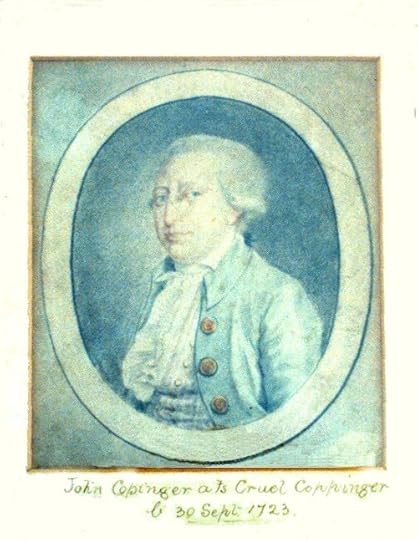
One man who during the 18thc acquired a lasting notoriety was that of ‘Cruel Coppinger,’
the Dane, who plied his dreadful trade along the north coast of Cornwall.
Local tradition relates that it was during a terrible storm a foreign rigged vessel was
seen drifting just off the coast. The ship soon sank in the pounding waves and driving
rain; just one man made it to shore. Wrapped in a cloak that he is said to have torn
from the shoulders of an old woman who was on the shore, the stranger leaped up
behind a farmer’s daughter who had ridden down to see the wreck. She took him to
her fathers house where he was fed, clothed and made welcome. He was fine looking
man and soon won the young girl’s heart and at her father’s death which happened
not long after, he married her. But the marriage was not a happy one and only one
child was born to them, a deaf and dumb boy who inherited his fathers vicious streak.
It was even rumoured that the child murdered one of his own playmates.
After the marriage Coppinger made himself Captain of an organized band of smugglers
and by his black deeds soon earned the title by which he is remembered. His ship was
called the Black Prince and had been specially built for him in Denmark and it was
rumoured to be crewed by men who had offended him on land. They were dragged
on board and threatened with violence if they did not sign on .
[image error]
After many years plying his wicked trade along the coast near St Just he fell ill.
Several parsons and members of the local church were called to his bedside, they came
readily enough as the wicked man was by then very rich. Although it was the middle
of a bright sunny day his chamber became very dark, and one Parson claimed to see
the Devil in the corner of the room. By their continuous readings throughout that day
they drove it to take many forms but for all their efforts they could not make the Devil
leave the chamber of the dying man. At last it took the form of a fly and buzzed around
Coppinger, by then they saw that it was in vain for them to try any longer. All the time
the bible readings were in progress, the men inside the room could quite clearly hear
the sound of waves breaking against the side of the house even though it stood some
distance from the shore. While this was going on two men who were on the cliff over
looking the sea heard a loud voice coming from the waves, it called out ‘The hour is
come but the man is not come.’ Looking in the direction of the voice they saw far out
to sea a black ship with a sail set coming in fast, against the wind and tide. No one
was visible on deck. She came closer and closer to the cliffs until only her mast could
be seen below them. Then as they watched in horrified amazement black clouds
billowed up from around her and then headed for the dying man’s house. Terrified, the
men ran back to the town square as they reached the house it shook and looked as if it
was about to collapse, and it was at this moment that old Coppinger died.
The Parsons and all the watchers rushed from his chamber and watched the black
clouds roll back towards the waiting black ship, which at once sailed away amidst
a violent lightening storm and then disappeared.
The sky overhead immediately cleared and nothing untoward happened until it was
time to place the old wrecker’s remains into the coffin. Then as the coffin was carried
towards the churchyard the sky again became overcast and a storm sprang up with
such violence that the bearers could hardly keep their feet. They managed to reach
the church yard stile when such violent bolts of lightening flashed around them that
they dropped the coffin and rushed into the church.
When the storm eventually abated they ventured out to retrieve the coffin but nothing
was left of it; only the handles and a few nails remained. All else had been set on fire
and consumed by the lightning.

There are many notorious tales of the smugglers and wreckers in this part
of the country and which has inspired many novels such as the
famous ‘Jamaica Inn ‘and ‘Moonfleet.’

One man who during the 18thc acquired a lasting notoriety was that of ‘Cruel Coppinger,’
the Dane, who plied his dreadful trade along the north coast of Cornwall.
Local tradition relates that it was during a terrible storm a foreign rigged vessel was
seen drifting just off the coast. The ship soon sank in the pounding waves and driving
rain; just one man made it to shore. Wrapped in a cloak that he is said to have torn
from the shoulders of an old woman who was on the shore, the stranger leaped up
behind a farmer’s daughter who had ridden down to see the wreck. She took him to
her fathers house where he was fed, clothed and made welcome. He was fine looking
man and soon won the young girl’s heart and at her father’s death which happened
not long after, he married her. But the marriage was not a happy one and only one
child was born to them, a deaf and dumb boy who inherited his fathers vicious streak.
It was even rumoured that the child murdered one of his own playmates.
After the marriage Coppinger made himself Captain of an organized band of smugglers
and by his black deeds soon earned the title by which he is remembered. His ship was
called the Black Prince and had been specially built for him in Denmark and it was
rumoured to be crewed by men who had offended him on land. They were dragged
on board and threatened with violence if they did not sign on .
[image error]
After many years plying his wicked trade along the coast near St Just he fell ill.
Several parsons and members of the local church were called to his bedside, they came
readily enough as the wicked man was by then very rich. Although it was the middle
of a bright sunny day his chamber became very dark, and one Parson claimed to see
the Devil in the corner of the room. By their continuous readings throughout that day
they drove it to take many forms but for all their efforts they could not make the Devil
leave the chamber of the dying man. At last it took the form of a fly and buzzed around
Coppinger, by then they saw that it was in vain for them to try any longer. All the time
the bible readings were in progress, the men inside the room could quite clearly hear
the sound of waves breaking against the side of the house even though it stood some
distance from the shore. While this was going on two men who were on the cliff over
looking the sea heard a loud voice coming from the waves, it called out ‘The hour is
come but the man is not come.’ Looking in the direction of the voice they saw far out
to sea a black ship with a sail set coming in fast, against the wind and tide. No one
was visible on deck. She came closer and closer to the cliffs until only her mast could
be seen below them. Then as they watched in horrified amazement black clouds
billowed up from around her and then headed for the dying man’s house. Terrified, the
men ran back to the town square as they reached the house it shook and looked as if it
was about to collapse, and it was at this moment that old Coppinger died.
The Parsons and all the watchers rushed from his chamber and watched the black
clouds roll back towards the waiting black ship, which at once sailed away amidst
a violent lightening storm and then disappeared.
The sky overhead immediately cleared and nothing untoward happened until it was
time to place the old wrecker’s remains into the coffin. Then as the coffin was carried
towards the churchyard the sky again became overcast and a storm sprang up with
such violence that the bearers could hardly keep their feet. They managed to reach
the church yard stile when such violent bolts of lightening flashed around them that
they dropped the coffin and rushed into the church.
When the storm eventually abated they ventured out to retrieve the coffin but nothing
was left of it; only the handles and a few nails remained. All else had been set on fire
and consumed by the lightning.
Published on December 14, 2014 07:03
November 16, 2014
Sheela Na Gig
The Sheela na Gig is another strange carving found in ecclesiastical buildings.
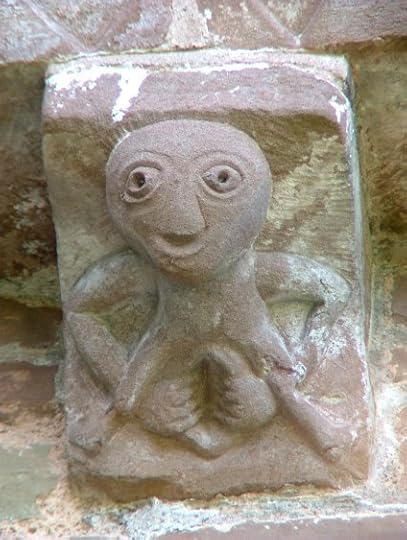
Sheela na Gig is probably a corrupt version of the Irish meaning 'old hag of the breasts' or 'of the hunkers', referring to the figure's typical pose with bent legs. Over one hundred carvings of these strange figures have been recorded in Ireland and over forty in Britain, many were lost here after zealous clergy removed or destroyed the statues.It is unsure where and when these images originated, some believe that they were first carved in Spain and France in the 11th century and then appeared in Britain and Ireland in the 12th century.
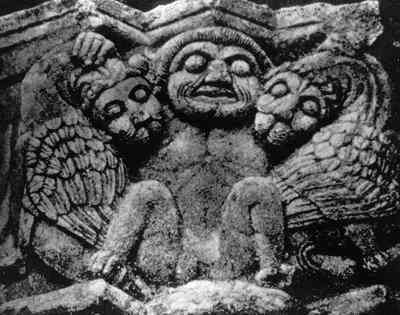
This image is from Piacenza in Italy.
The images of naked women displaying an exaggerated vulva is said to ward off death and evil and are usually placed over doors or windows to protect the openings. In Ireland the name of Sheela na Gig directly refers to the local wise women of the time, otherwise known as the Hag. She would have carried on with her spell weaving and cures despite the churches disapproval, and would have still been consulted by the locals if they wanted to avert ill luck. Her main method of averting the evil eye was to expose herself to the victim.There is evidence in ancient folklore of anasyrma being used by women lifting up their dresses to curse evil spirits. Anasyrma is the gesture of lifting the skirt or kilt to expose the genitals. It has been used in connection with religious rituals, eroticism and rude jokes.
[image error]
Like the images of mermaids that can be found in churches, it is also thought that Sheela na Gig images are a warning against female lust, while others believe that she is a remnant of pre Christian fertility or mother goddess. This would explain why there is evidence of the statues being rubbed by pilgrims, the power of the dust from the carving was believed to have special healing powers. The statue of the Sheela na Gig at Castlemagner in Ireland clearly shows this by the wear on the figure, especially around the sacred centre of feminine power, the vulva itself.
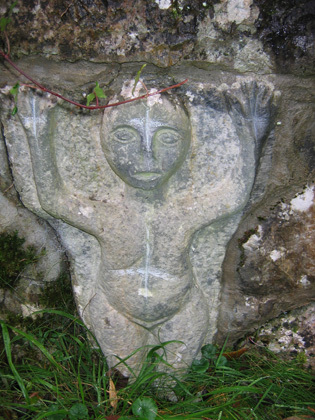
This example, one of the best preserved figures, is believed to have come fromthe ruins of an 8th century church in Subulter which fell into disrepair in the 15th century. This figure and another of St Michael can be found on either side of the well which is dedicated to St Brigid.
Published on November 16, 2014 04:11
November 7, 2014
The Green Man

The Green Man is believed to be a pagan, perhaps a fertility figure or a nature spirit, similar to the woodwose and yet carvings of The Green Man can still be seen on many ecclesiastical and secular buildings, although the true meaning of these images have been lost. They are usually viewed as symbols of rebirth, representing the cycle of growth each spring. The face is surrounded by or made from leaves. Branches or vines may sprout from the nose, mouth or nostrils which may bear flowers or fruit.
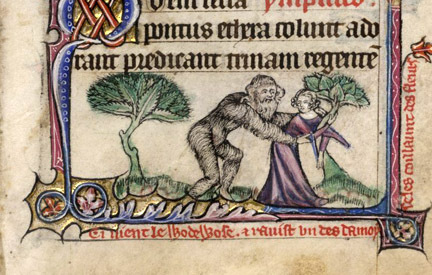
The Woodwose ‘wildman of the woods’ is a mythical figure that appears in the artwork and literature of medieval Europe and is comparable to the faun or satyr.They are depicted as being covered in hair, images of these wild men appear in the carved and painted roof bosses of Canterbury Cathedral,
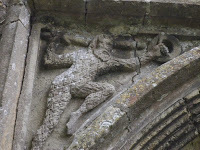
Images of the Green Man are to be found here as well.
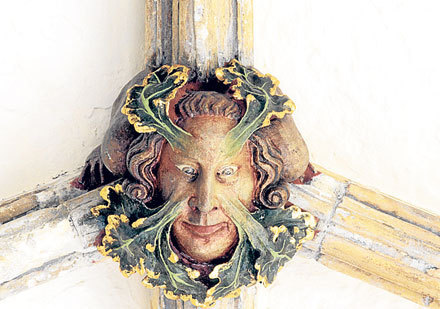
There are three main types of the Green Man carving.
The foliate head which is completely covered in green leaves.
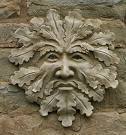
The disgorging head which spews out vegetation from the mouth.
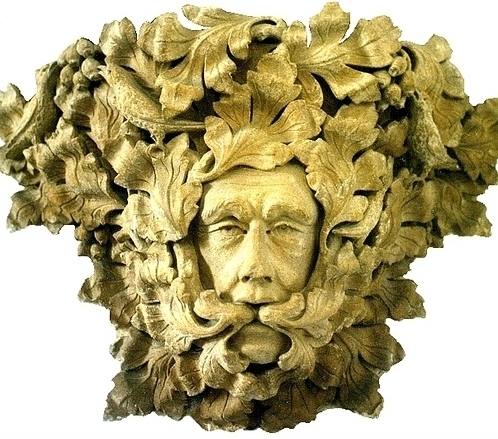 The bloodsucker head which sprouts vegetation from all its facial orifices.
The bloodsucker head which sprouts vegetation from all its facial orifices.
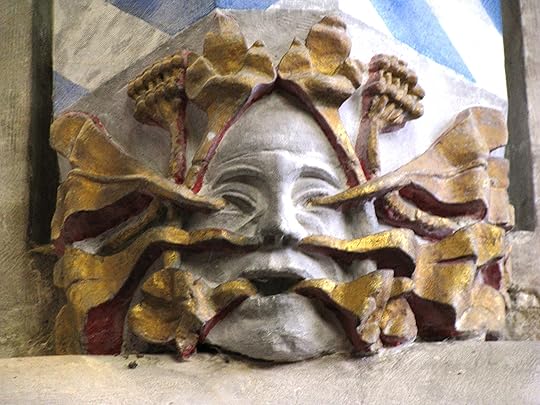
The image of the Green Man do not appear in England until the twelfth century but they have a long history elsewhere. In Rome during the first century AD foliate heads were produced as ornamentson temple friezes and capitals, this spread throughout the Roman Empire. The foliate heads also appear in Indian art from the eighth century onwards. The first image of this kind appeared in Europe on the tomb of St Abre, near the city of Poitiers, France, 400 ADThis area saw the development of the carvings in the gothic style.Of course the Celts already used curving twisting forms of vegetation in their art long before the Romans invaded, images that could be viewed as both animal or vegetation and human heads at the same time. There are many examples in illuminated manuscripts which may have been used as inspiration for carvings.
The Green Man image is usually found at boundaries or crossing places, beside a church door, the chancel arch or screens. They can also be found hiding under misericords in many churches, such as Exeter Cathedral, the abbey-church of Vendôme, France, Ludlow parish church and many more.
[image error]
The Green Man enjoyed a revival in the 19th century, becoming popular with architects during the Gothic revival and the Arts and Crafts era, when it appeared as a decorative motif in and on many buildings, both religious and secular. American architects took up the motif around the same time. The Green Man went with the Europeans as they travelled around the world. Many variations can be found in Neo-gothic Victorian architecture. He was very popular amongst Australian stonemasons and can be found on many secular and sacred buildings.
The celebration of the Green Man is still going on today; in Clun in Shropshire over the three days of the first May bank holiday the Green Man festival is held. On the bank holiday Monday the Green Man enters Clun to battle the spirit of winter at Clun Bridge and a May fair is held in the grounds of Clun Castle with a May Queen.
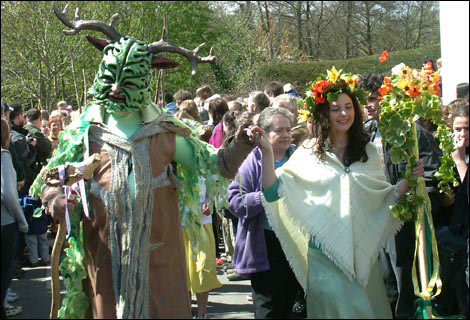
Published on November 07, 2014 04:42
October 27, 2014
Witchcraft in Somerset

Samhain, otherwise know as All Hallows Eve and most commonly Halloween, is one of the biggest festivals in the witches’ calendar, it marks the end of the
Celtic old year and the start of the new. It is on this night that the veil between
the world of the living and that of the dead is at it’s thinnest, allowing the souls
of the departed to cross over. It is also the time that witches gather together
to celebrate one of their biggest sabbats. In medieval time on nights like this
when witches were believed to be about, church bells would be rung to stop
them flying over the villages and towns; all of the inhabitants would come out
into the streets armed with hand bells, old pots and pans, anything that would
add to the noise. It was believed that the noise of the bells ringing in the night
would cause the witch to fall off her broomstick and fall to the ground. Belief in witchcraft was widespread throughout the county and according to an historical document written in 1681 Somerset was awash with witches; one
could almost imagine the night skies filled with flying hags!
Joseph Glanvil, a demonologist and clergyman living in Frome, gives a detailed
account in his Sadducismus Triumphatus of the two great covens, one at Brewham
and the other at Wincanton, situated just miles from Glastonbury, which was and
still is the ancient seat of Pagan forces. As well as the ringing and wearing of bells the people of Somerset took other steps to protect themselves against witchcraft as the many artifacts found will testify.

A number of witch bottles have been discovered hidden in old buildings, these
were a favourite tool to counter any evil spells. Anybody thinking they had
been bewitched would fill the bottle with pins, their urine and nail clippings
and then hide it somewhere, usually beneath the front doorstep or the fireplace.
Bullocks hearts stuffed with pins were placed in chimneys to stop entry by a witch;
horseshoes, often seen over doorways,were placed there to break the spell of an
evil wisher and even animals, usually cats, were crucified in the roof space of
houses. But the simplest witch deterrent was urine, it was sprinkled over the
doorstep to prevent entry and in some cases sprinkled over people to prevent
bewitchment.

Less common was the finding of any witches belongings although an interesting
discovery was made in Wellington in 1878 when workmen broke into a secret room in an old house that was being demolished. Inside they found a Witch’s
Ladder, an armchair and six well used brooms. The ladder, which is now in the
Pitt Rivers Museum in Oxford, is a long length of knotted cord with feathers
woven into it and would have been used to cast spells, usually a death spell.
Strangely enough the room situated in the roof space was inaccessible from
the main house but according to many, witches were able to fly by anointing
themselves with ointment made of the fat of young babies, hemlock, aconite,
poplar leaves and soot.
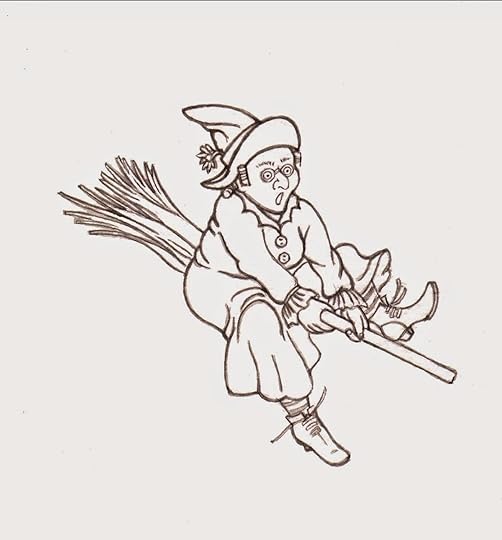
It was also a common belief that witches were able to transform themselves by using a magical spell into ‘familiars’, a toad or frog but most frequently a hare.
“ I shall go into a hareWith sorrow and such and muckle careAnd I shall go in the devil’s nameAy ‘till I come home again”
There is a story of a witch in Wambrook, who having caused much trouble and
strife in the area, was shot by a resident of the village. He spotted a hare running
through the village and believing it was the witch who in the form of her familiar
had been suckling milk from his neighbour’s cow ran to get his gun. His first shot
had no effect so he loaded his gun with silver pennies. With his second shot he hit
the hare. Chasing it back to the old woman’s cottage he found her crouched in the
corner of the room with blood pouring from her leg. There are many tales of old
women transforming themselves to escape pursuit; Black Smock Inn at Stathe was
named after a witch who flew up the chimney and ran off across the moors in the
shape of a hare, although she avoided the flames her clothing got scorched in the
hot chimney. Mother Weller from Milborne Port was another witch who could
transform at will but her favourite form was a toad. Greatly feared in the area she
was known to possess the evil eye. Whole litters of pigs would die, horses would go
lame and cattle would sicken and die; any misfortune that occurred in the area would be laid at her door. She met her end at the hands of a disgruntled
local farmer, who finding a toad sat in the doorway of her cottage stabbed it with
a fork. Mother Weller was found dead the next morning with stab wounds in her back.
The strong belief in the power of ‘overlooking ‘or the evil eye formed the basis
of many of the witch craft trials that swept the country in the 16th and 17th century.Mathew Hopkins was the most notorious Witch Finder General in Britain but
Somerset had it’s own witch finder; Richard Hunt JP. He personally led a zealous
hunt for eight years, tracking down ‘a hellish knot of witches’ in Somerset and
presided over the many cases of suspected witchcraft brought forward at the
Assizes held in Taunton Castle. Elizabeth Stile, a member of the Wincanton witches, was accused in 1665 of
bewitching Elizabeth Hall into having such severe fits that she was unable to speak.
Stile wildly confessed to having made a pact with the Devil. She was examined in
court by five women, two of which historical records show were professional
witch finders. Known as ‘prickers’ they searched the accused’s body for witches
marks; which would signify that they had been touched by the Devil. Any blemish,
birthmark or spot would be suspect. Once a mark was found it would be pricked
with a bodkin or needle to see if the witch could feel any pain. These people
would travel from town to town to uncover witches for a hefty fee; one ‘pricker’ was reputed to earn 20 shillings for each witch that was uncovered. However they
were not averse to falsifying evidence, some of the bodkins, a sharp instrument
made for punching holes through cloth, and needles they used had hollow
wooden handles and a retractable needle so although it looked as though the
needle had entered the body it had in fact disappeared up into the handle.
On being found guilty Elizabeth Stile was condemned to be hanged but thwarted
her gaolers by dying a day before her sentence was due to be carried out.
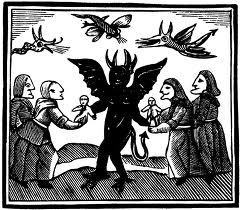
One of the most bizarre case was that of Mary Hill of Beckington, who in 1689
accused Elizabeth Carrier, an elderly women of bewitching her after she began
to have severe fits during which she vomited up a number of strange objects.
Beginning with pins then nails then within a month it progressed to handles of
spoons, lumps of lead, iron, more pins tied up with thread and large nails.
The woman she accused were searched and found to have several witches marks.
After being ‘cross bound,’ her right thumb tied to her left big toe, she was thrown
into the river near the town.
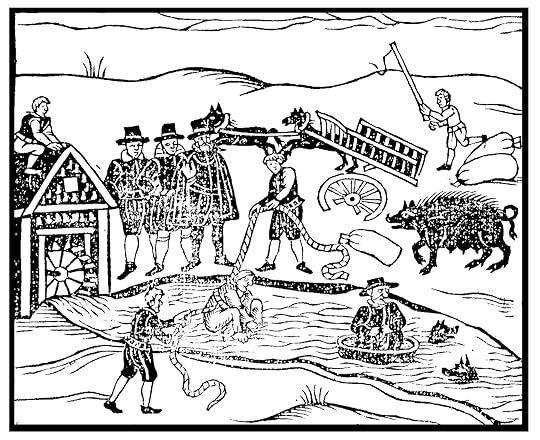
Ducking or ‘swimming the witch’ was another popular method in determining
the guilt of a suspected witch. If she floated after being thrown into deep water
it was a sure sign that she was a witch. Margery Coombes and Ann More, both
elderly woman, were also accused by Mary as she continued to vomit up strange
objects. Elizabeth Carrier died as soon as she was in prison but the other two
were tried at the Assizes and acquitted due to lack of evidence.Authorities were becoming increasingly sceptical of so called evidence but many maintained that Mary was possessed of a diabolical presence.
But of course the most well known witch in Somerset is the Witch of Wookey.
According to locals the witch had been spurned in love and had retreated to the
cave where she spent her time casting evil spells on the young of the village.
In desperation they appealed to the Abbot of Glastonbury to rid them of the witch
so a monk was dispatched to confront her. On seeing him she tried to flee her
cave but the monk managed to sprinkle her with Holy Water as she rushed past,
as soon as the Holy Water touched her skin the witch turned to stone and there
she remains to this day.
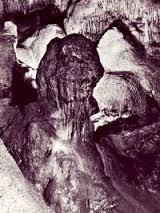
Many innocent women were also accused of being witches, the exact amount
executed vary wildly according to different historians. Elderly, single, infirm
or simple, anybody that was outside the mainstream of village life, or even
owning a pet was suspect behaviour.
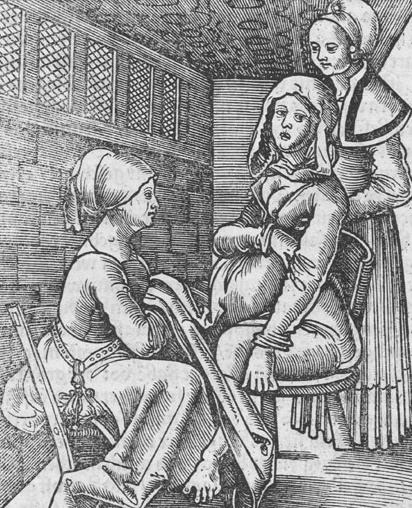 The so called wise women who were proficient in the use of herbs and midwives
The so called wise women who were proficient in the use of herbs and midwives also began to fall under suspicion as well but by the late 17th century thanks
to a growing scepticism, the cases of witchcraft began to decrease with the
Witch craft Act being repealed in 1736. The last case in Somerset was that of
Maria Stevens in 1707 who was accused of bewitching Dorothy Reeves, she
was acquitted after the judge and jury failed to believe any of the evidence.
Contrary to popular opinion witchcraft is still alive and well in Somerset, although changed somewhat from the image of old, gone are the pointed hats and broomsticks. The modern day witch is usually a devotee of Wicca; whose practices involves working in harmony with nature, magic, folk medicine, spiritual healing and shamanism.
The popular Wytches Market held twice yearly in Glastonbury is a testament to
the enduring draw of this ancient and sacred site for all types of pilgrims, pagans,
witches, druids and Christians alike.

.
Published on October 27, 2014 12:41



